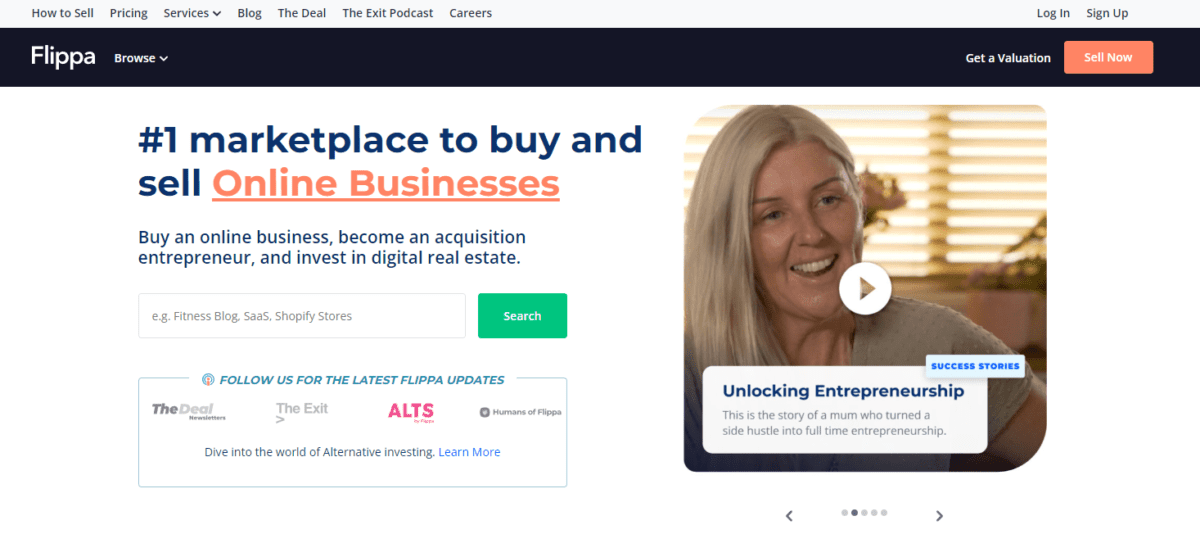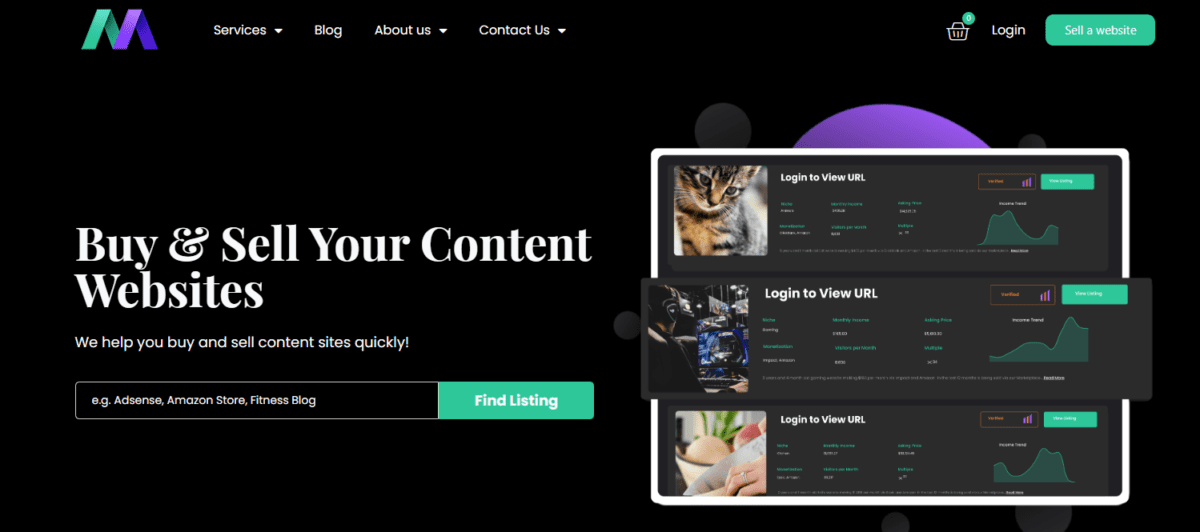Shopify is a powerful ecommerce platform used by millions of stores. It allows you to create your own online shop without a developer or programming knowledge, which is perfect for beginners.
This is why many entrepreneurs use Shopify to give their products a web presence. Just add your products, choose a Shopify theme, and your site is live. You don’t even need to worry about web hosting.

For those who launch a successful Shopify store, selling the business can be a tempting idea. Other companies looking to expand will pay good money for a successful ecommerce store with strong sales and traffic. You can take that money and run, or use it to invest in another project like launching a brand new Shopify store!
Why You Should Sell Your Shopify Store
Selling a Shopify store can be very profitable. You have probably spent years building your brand, improving your catalog, and attracting a customer base. These things have made your internet shop profitable and valuable, which is very enticing to other business owners.
By simply buying a Shopify store, the new owner can skip all of the difficult early days and long nights. The risks are significantly less to buy an established business than start a brand new one. At the same time, an established Shopify store bringing in a healthy profit doesn’t come cheap.
Pros
If you are ready to move on from your Shopify store, whether to retire or pursue other endeavors, selling your shop is the way to go. You can receive a large lump sum for your years of hard work, letting someone else take over the business and continue to serve your customers.
Cons
While selling your Shopify store can be a very exciting time, don’t lose sight of the big picture. Seller’s remorse is common when selling a company, so be sure you have thought your decision through.
Coming up with a valuation for your company can be tricky. Say your company business profits $100,000 per year. How much is it worth? One year’s profit? Two years? Five years? Determining this can be difficult, and there are other factors like the amount of work needed to run the business, physical products and other capital owned by the company, and the outlook of the industry.
Lastly, for many business owners, their store is their professional purpose on a daily basis. While it can be tempting to sell your company for a large sum of money, you should have a plan about what to do next. Selling your Shopify store can leave you without a job, steady income, and purpose, which you may end up regretting.
You may also not like changes that the new owner makes to your company, something you spent years of blood, sweat, and tears building from scratch. Be sure you want to sell before signing the papers, and consider what you will do after, such as launching a new business, taking another job, or retiring.
What’s the Value of Your Store?
Determining the value of a business is not an exact science. There are many theories and formulas used by experienced buyers and brokers, but none are universal.
Calculate your seller’s discretionary earnings (SDE)
The best equation for most Shopify stores is the seller’s discretionary earnings (or SDE). This formula is commonly used to calculate the yearly benefit of small businesses to their owner. Here is the breakdown:

By taking the annual revenue and subtracting the cost of goods sold and operating expenses, you come up with the yearly profit. You should not count the owner’s salary as an expense since that is a direct benefit to the new owner. You should also leave out any unusual expenses, such as a one-time repair or optional upgrade since those are not costs the new owner will incur.
This will give you an accurate estimate of how much value a business generates for Shopify store owners in a year. How the owner uses those profits is discretionary.
The tricky part is that now you know the value your store generated each year, but how does that translate to the total worth of the business? Unfortunately, there is no easy answer to that. Usually, a company is worth more than one year’s profits but less than five years’ profits. Determining that multiple is the main challenge of negotiating a final price, especially if your store has seen substantial growth.
Factors that impact your store’s value
While your store’s SDE will form the core of your business valuation, there is a wide range of factors that can make your Shopify store more or less attractive to potential buyers.
Your business model
Your business model can determine whether your store is a good acquisition for another company. It can also make your store more attractive to individual buyers.
Do you have the majority of your business processes automated through software, third-party assistance, and o? This can make your store much more attractive to buyers than if you spend 40+ hours a week running things as the owner.
The more hands-off and established your business model is, the better. Buyers want to be able to purchase your store and keep it running with minimal effort, not acquire a project that takes considerable effort to manage and improve.
Sources of revenue
Does your Shopify store strictly generate income from product sales, or have you diversified your revenue streams? While selling products is probably the primary source of revenue for your Shopify store, having other sources of income can make your business much more versatile.
For example, if your Shopify store comes with a significant social following, affiliate marketing deals, and monthly ad revenue, the new owner can leverage those perks for other benefits. This is especially true for companies looking to add your shop to an existing network.
Diverse sources of revenue offer more flexibility in how your store will benefit the new owner, giving them more options for monetization and new business opportunities for any existing network.
Current finances
The financial state of your business depends on more than just your SDE. Companies with similar SDE can have drastically different finances depending on other underlying factors.
Important numbers that you should have records of regarding your current finances include:
- Profit
- Debt
- Margins
- Growth rate
- Overhead costs
- Market share
- Liquidity
Any of these factors can strengthen or weaken a business’s valuation.
For example, imagine two similarly valued Shopify stores. One has notably higher margins and a significant market share, while the other relies on razor-thin margins to beat the sizable competition. Assuming all other factors are comparable, it is clear which store is a better buy.
Brand establishment
When selling your Shopify store, you are likely also selling the brand tied to the store. This is an integral part of your business and can be a large part of the value.

In general, startups are worth less than established brands because they are at higher risk. A Shopify store that has been profitable for ten years is a better investment than a new shop with only one profitable year under its belt.
There is also value in the popularity of a brand. A household name is much more valuable than a startup company known by a few.
Number of users
In addition to sales and profit, traffic is a valuable metric for stores being sold. The reason is simple: the new owner has a greater potential for success if more shoppers are visiting the store.
Even if those visitors aren’t converting now, it is better to have them and try to fix that than to have fewer visitors. If you have impressive traffic to your site, include the Google Analytics data in your sales pitch.
Variety of assets
In addition to the rights to your Shopify store, you will probably be including other assets in the sale. For example, if you stock inventory, that will probably go to the new owner as a part of the transaction.
Other assets can include physical goods, property, and intellectual property. For example, the new owner may want to acquire the warehouse space you are currently using. There may also be digital assets or copyrighted material you are signing over. These can increase the value of your Shopify store.
How to Increase Your Shopify Store’s Value
While the main value of your store will be derived from its sales, traffic, and track record, there are a few things you can do to add curb appeal and boost the asking price. Here are some examples:
Update the UI
Updating your UI is like new paint and polish for a brick-and-mortar store. If there are any updates you’ve been meaning to do but haven’t had the time to, consider implementing them prior to the sale.

An optimized user interface can drastically improve the first impression (and even the sale price). There are two main things you should pay attention to before the sale.
Intuitive
Your UI should be as intuitive as possible. You want prospective buyers to have an easy time exploring your site. This will not only give them a better experience and allow them to find anything they are looking for but show that the site’s quality is suitable for users.
Mobile-friendly
A huge red flag for an ecommerce website is if it is not mobile-friendly. What was once a helpful perk has now become an undisputed necessity. If every corner of your Shopify store isn’t mobile-friendly, it’s time to fix that.
Analyze and upgrade processes
Any other upgrades or pain points you can address are worth doing before a sale. You can amplify the value of your Shopify store by having everything optimized and up-to-date.
Audit your SEO, test links and menus, review analytics, clean up email lists, and anything that a prospective buyer may want to check before making an offer.

It may seem like a waste of time to improve your store before handing it over to someone else, but spending a few hours analyzing and tweaking your operation can result in a higher sale price.
Get your finances organized
Calculating your store’s SDE, profit, and other financials is easy. You also need to be able to prove those figures with clean and easy-to-follow books.
Buyers aren’t just going to take your word for it when you tell them what your company is worth. They also may be inheriting any debt or financial obligations associated with your business. They will want proof of your finances to ensure they are making a wise purchase and numbers reflect your claims.
Look over and update your terms of service
Your terms of service are essential for protecting your business from shady customers and unnecessary liability. You might never have had any issues with that sort of thing, but a buyer is probably going to look closer than anyone has before.
If your terms of service are incomplete or full of errors, a buyer may be reluctant to move forward and open themselves up to potential liability.
Get employment contracts ready
If you employ contractors who are essential to the daily function of your Shopify store, review those contracts to ensure they are up to date and ready for the new owner. Likewise, if you plan to continue working for the company after selling it, have a contract drafted with the terms of that agreement. This will ensure a smooth transition for all parties.
Focus on sales & traffic
Once you start trying to sell your Shopify store, it can be easy to let the daily operation fall by the wayside. That is the last thing you want to do!
Don’t think you can save a few bucks by stopping ordering new inventory, turning off paid marketing, or coasting on regular operations. Until the sale is complete, it is vital to keep your business running at full speed.
A sudden drop in sales or traffic the month before closing a deal can be a big red flag. Keep your shop striving and growing to prove its value to interested buyers.
Where to Start Selling Your Shopify Store
Selling your Shopify store, like selling a business, can seem overwhelming if you have never gone through the process before. It’s not as simple as selling a physical item since it is focused primarily on the site’s credentials, business records, and intellectual property.
Believe it or not, there are online marketplaces designed specifically for selling online businesses, like a Shopify store. These platforms are not that different from marketplaces like eBay or Amazon, except they facilitate the sale of companies instead of consumer goods!
There is also the old-fashioned method of selling directly to another company or using a broker. Read on to learn more.
Reach out directly to a buyer
You may have received offers in the past to buy your Shopify store. You may not have been interested at the time, but that offer is a good lead. There may be other leads you are aware of, such as director competitors, whom you know would be interested in acquiring your internet shop.
If so, you can reach out directly and attempt to strike a deal. There is no harm in reaching out and opening a discussion, just don’t be hasty and agree to anything before you’ve had a chance to think it over. Calculate your SDE and come up with a fair valuation, and don’t be afraid to get multiple offers, so you know you are getting a fair price.
Use an online business marketplace
Online business marketplaces are a simple concept for a complex scenario. Not unlike online marketplaces used to buy and sell products, there are business marketplaces that allow sellers to connect with buyers looking to acquire new apps, websites, and ecommerce businesses.
Flippa

Flippa is a marketplace for selling websites, online businesses, and more. It operates much like the Exchange but is not directly affiliated with or focused on Shopify stores.
You can still absolutely sell a Shopify store here, you just need to handle the Shopify account transfer on your own. The benefit of Flippa is they offer a valuation tool, legal resources, and even brokers to assist with sales. Expect to pay a few hundred dollars for a listing and sale, possibly more with add-ons.
Motion Invest

Motion Invest is a newer marketplace for buying and selling websites, though they boast a 97% sale rate. This is partially due to their Dutch auction process of selling.
With this method, their team comes up with a fair valuation of your site and posts it. At auction time, if no buyers step forward, the price is lowered. This will continue until a price is reached and an interested buyer accepts the offer.
While this process gives you less control over the real sale price, it all but guarantees a quick sale, and the team at Motion Invest handles most of the listing process, much like a broker. They will even assist with the handover process to the new owner. This is an excellent option if you want a more hands-off approach.
Empire Flippers

Empire Flippers is another option that will handle most of the work for you, though they have higher standards than the other options on this list. They focus more on established businesses with high monthly revenue and vet prospective sellers thoroughly.
If you are looking for a professional team to help get you the best price for a very successful, established business, this may be a good option for you. For small Shopify stores, you might not make the cut.
Hire a business broker
To really make things easy, you can hire a business broker with experience buying and selling stores. They can advise you on the process, help with contracts, negotiation, and valuation, and even find you a buyer for a private sale. The downside is they will take a percentage of the successful sale price, much like a real estate agent does when facilitating the sale of a house.
However, they will have immediate access to the best sales channels and know how to get the best price for your Shopify website. In the end, a broker might even earn you more money from the sale.
FAQs
What Comes Next?
Once you are positive you want to sell your Shopify store, the next step is to decide which avenue you wish to use. If you already have some prospective buyers, start there. Otherwise, the Exchange Marketplace is a great option.
Research how the process works, come up with a valuation for your business, and get ready to negotiate!










